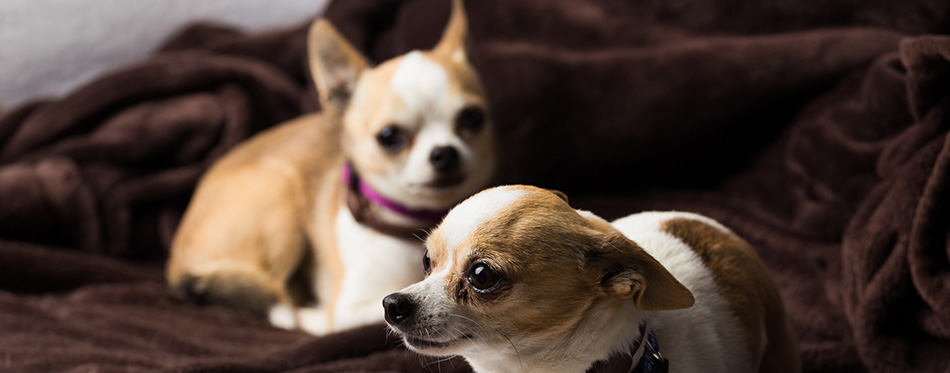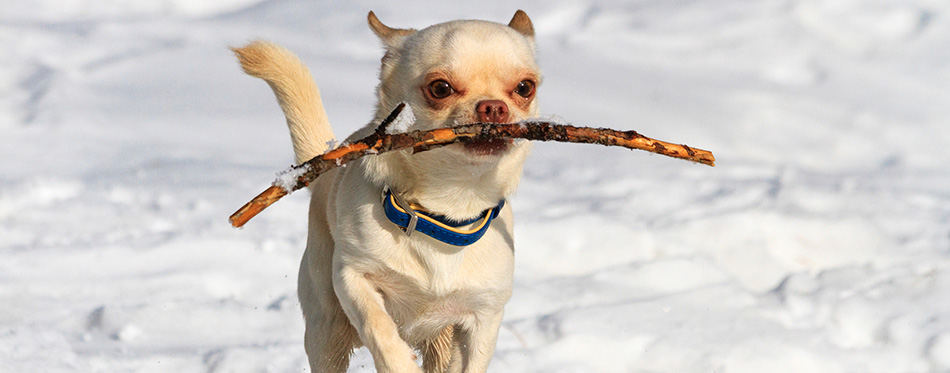We have so many unique dog breeds worldwide, but the Teacup Chihuahua appears to be the smallest of them all. With its typical body weight that ranges from 3-6 pounds, the toy-like dog occupies the number one position on the list of small dogs. However, we have seen some variations in size, color, shape, as well as the coat type. The breed has gained popularity, thanks to their miniature size and unflinching loyalty to its adopters. But the question is; is this out-and-out lap dog right for your family? Now let’s take a good look at the characteristics of the Teacup Chihuahua.

History of the Teacup Chihuahua
It is generally believed that the Chihuahua is a descendant of the Techichi – a South American dog or some tiny hairless dog of Chinese origin. Talking about the Techichi, the small pooch was a breed of choice during the time that Mexico was under the rule of the Toltec tribe in the ninth century, which was about one thousand years ago. This ancient dog was heavier and larger than what we currently have in existence today.
With the Aztecs vanquish of the Toltecs in the 12th century, the Techichi was refined into a relatively lighter and smaller dog. With the advent of the 1500s, when Aztec was overthrown by the Spanish conquistadors, the breed was considered an essential part of the culture in Aztec. According to findings from the colonial records, the population of the Chihuahuas was pegged in high numbers, which only means that the region was largely populated by this tiny dog breed.
Some wheeled dog toys which were believed to have represented the tiny Chihuahua were uncovered from digs in El Salvador, Mexico. There were also findings in Tres Zapotes in Veracruz Mexico, the first of these findings were unearthed and dated back to 100 AD. Other discoveries include dog effigy pots which were discovered in Tennessee as well as Georgia, and all appeared to represent the tiny Chihuahua, and they were all dated back 1325 AD. Casas Grande’s site excavations in 1850 which was carried out in the Mexican state of Chihuahua revealed a pot featuring a Chihuahua which was brought by the survivors of Casas Grandes, following its attack by the Opatas.
A letter from Hernan Cortes dated 1520 mentioned that the reason Aztecs breed the dog was to sell them for food. A tiny dog like a Chihuahua was then used to perform the function of a hot water bottle as the belief then was that, pain is transferable from human to animal. This also ushered in the era of rituals where dogs such as Techichi were burnt to appease some deceased human spirit.
It was Judge James Watson that brought the first Chihuahua into the US, on his return journey from Mexico after investigating the breed. James named his feisty friend Manzanita meaning little apple probably because of its apple-shaped head. The AKC recognized the breed during the 1960s, and before the end of the decade, it made the top 10 list of the decade. The Teacup Chihuahua has never been recognized as a different breed, and it comes with exactly the same history, and no kennel club has recognized them as an independent breed. The name is just something that breeders use to describe a mini or micro-sized Chihuahua.
Quick Facts About the Teacup Chihuahua
When your pet is the tiny sized Chihuahua, then you have a companion that will always be by your side every step of the way. No matter the activity you are engaged in at home, your little friend is most likely to be close by at every time, and in terms of presence, it can be treated as a constant factor. In view of all these, you as the dog parent need to acquaint yourself with all the important facts about the breed to aid you in relating well with it. Below are a good number of quick facts about the Teacup Chihuahua;
- The Chihuahuas that are referred to as Teacup Chihuahuas are the miniature size of the original breed, and the name is also a term used by the Americans to describe the dog’s size. These tiny dogs are named thus, due to the fact that the breed can easily fit within a teacup. Some people also refer to them as Toy Chihuahuas.
- As a result of its small size and complete lack of athletic capabilities, the Teacup Chihuahua was exclusively bred for the purpose of companionship.
- There is no standardized size for this breed, but generally, the dog comes in sizes that range from six to nine inches, which are approximately 15 to 23 cm. However, we have seen some Teacup Chihuahuas that are 12 to 15 inches in height or 30 to 38 cm. As for their weight, the breed can weigh as much as 2.7 kg or 6lbs or less, but confirmation is still pending on this.
- The dog is a trainer’s delight because of its high intelligence, besides; they exhibit an admirable eagerness to learn, which makes them a whole lot easier to train.
- Talking about exercise, and grooming, Teacup Chihuahuas are known to be a relatively low-maintenance breed of dogs.
- One thing pet parents should bear in mind is that; this tiny dog is highly averse to wet weather, as well as cold.
- In the same ways like every other dog of miniature size, the breed is a fragile one, and thus should not be left in the company of kids as they are not child-friendly at all. A toddler is enough to unknowingly harm the dog when allowed to play with it, though the action may be a well-meaning one.
- Averagely, the lifespan of the Teacup Chihuahua can go from 12 to 20 years, though you can possibly extend it by ensuring that they receive the utmost care and nutrition. The Teacup Chihuahuas that come with less than three pounds in body weight usually have a shorter life span.
- As for the appearance of the breed, it comes in a tiny frame with a head that is shaped like an apple. Two rounded and large eyes, a couple of large erect ears that respond to their environment through subtle movements. In explanation, the little dog may try to show aggression or let you know that it is threatened by flattening their ears and putting it back up immediately. Their coats can either come in solid colors or in combos; we can have white, gold, chocolate, black, fawn, or cream. We also have combos of white with fawn or white with black.
- The breed’s strong sense of loyalty and devotion makes them particularly good as guard dogs. However, constant supervision is recommended.
- The Teacup Chihuahuas are completely ignorant of their tiny size, and thus, they don’t hesitate one bit when it comes to challenging a bigger hound which usually portends harm for them.
- The Teacup Chihuahua comes with a clannish attitude in dealing with other breeds of dogs as they are known to have a preference for their fellow Chihuahuas when it comes to socializing. There are many of them who only mix with Teacup Chihuahua.
- The breed loves things like a blanket, pillows, and cloth hampers, as they like to burrow into them and use them as dens. They have a preference for under covers, beneath or under a bed bottom. However, the dog tends to enjoy some good exposure to the sun from time to time, especially because of their natural aversion to cold.
- The puppies of the Teacup Chihuahuas come out very tiny but will grow to their full size with time. However, they may not be able to grow to the max size if undernourished.
- They can easily adapt to any living situation as a result of their small size; the breed is known to comfortably fit into apartments, and can adapt to both country and suburban living.

Things You Should Know
Health
The Teacup Chihuahuas have a plethora of health problems which include;
- Hydrocephalus: This kind of health issue is common with other toy breeds within the canine population. The symptoms of the disease include; abnormally enlarged heads, lethargy, and stunted growth.
- Collapsed Trachea: With this kind of health problem, the dog’s cartilaginous rings in the trachea are weakened, or in some cases, they are malformed. The condition can be congenital and most times acquired and is common among other tiny canine breeds like; Pomeranian, Yorkshire Terrier, Toy Poodle, Maltese Pug, Shih Tzu, as well as Lhasa Apso.
- Pulmonic Stenosis: this is what to expect when there is an obstruction of the outflow of blood from the right ventricle of the dog’s heart.
- Molera: This is common with the apple headed Chihuahuas, and comes in the form of a soft spot on their skull. The Teacup Chihuahua is born with this particular condition; however, a molera is not seen as a defect, rather, it is regarded as a normal adaptation, because of its function of facilitating a puppy’s passage via the birth canal. It also functions in aiding the development, and growth of the pup’s skull. Eventually, all molera spots close up as the puppy matures into an adult. However, the initial six months of the pup’s life is crucial, as you need to be extra careful to prevent it from incurring a head injury. Molera is known to completely close up in several cases.
- Hypoglycemia: This is called low blood sugar. The symptoms are realized as fainting, neck muscle spasm, sleepiness, seizures, unfocused vision, lethargy, head pulling back and sideways, as well as uncoordinated movement. The solution is in the use of sugar supplements such a Nutri-Cal, honey, and Karo syrup.
- Obesity: This is the resultant effect of overfeeding, and the dog parent takes the blame. The dog’s nutrition needs to be cut down, and directions must be strictly followed.
- Chronic bronchitis: This is a side effect of obesity in the Teacup Chihuahuas.
- Susceptibility to cold: When it is exposed to cold weather, the dog will tremble or shiver, and Chihuahuas with short hair are the ones affected the most. While the winter is biting hard, you may need to get some sweaters and boots for your canine friend. You can also keep them warm by exposing the dogs to sunshine, stuffing them under the blanket, in the furniture, or even human laps.
- Shortened life span: this is also a side effect of obesity.
- Heart-related disorder: Instances can be seen in pulmonic stenosis, and heart tremors.
- Eye injury or infection: This is common with the Chihuahuas that come with protruding eyes. They usually have watery eyes as a result of dust, dry air, or the presence of airborne allergens.
When it comes to mitigation and prevention, the health issues of a Teacup Chihuahua are easily dealt with. Simple methods can take care of the issues, but when it is a serious health condition, the vet’s attention will be required.
Training
Training a dog to respect its human adopters will come in handy in the long run, as it will make any other training method you wish to try a whole lot easier. Once the Teacup Chihuahua imbibes respect as a habit, it will obey any command you issue, especially when you want it to tone down some kinds of behaviors. Another good training method is socializing, and with this particular dog breed, meeting with strangers can go either way; at best, the dog will come across as reserved, but in the worst-case scenario, it can burst out in outright hostility. Early socialization can make your canine companion be more acceptable to visitors and strangers.
You can also try training the Teacup Chihuahua to overcome its usual separation anxiety, which usually occurs anytime the dog is left alone for a long time. Once anxiety sets in, the dog will start chewing things and barking incessantly. It is highly essential that you expose the dog to potty training early enough, and the best time to start is immediately you acquire one. Inculcate in your pet that passing poop inside the house is a bad habit, and teach it how to go outside anytime it feels the need. Also, teach the dog to reduce its constant barking by letting it know that you won’t tolerate such behavior.
Your training method should be gentle but firm if the dog views you as too soft, then you have a big problem in the form of a spoilt pet that will not respect you one bit, neither will it obey your command.
Related Post: Indoor Dog Potty

Exercise
The Teacup Chihuahua’s small size does not call for vigorous exercise; however, you can walk the dog from time to time and allow it to go play outside.
Nutrition
It is a known fact that small-sized dogs only need 40 calories for a pound of their body weight; thus, the requirement of an average Teacup Chihuahua is 150 calories in a day. If you feed your pet twice a day, then each meal will have 75 calories. Thanks to their miniature size, the dog comes with a relatively small stomach, as well as little energy requirements, so it comes as no surprise that their nutritional requirements will also be as small. Recommendations are that pet parents feed their dogs with high-quality kibble, which are specially made for smaller breeds. These specialized diets are purposely created to meet the breeds specific, protein, energy, and fat requirement.
For more guides on choosing the right dog food, you may wish to check out our reviews of the best dry dog food, organic dog food, dog food for small dogs, wet dog food and dog food for chihuahuas.
Grooming
If you are the type that doesn’t have time for grooming, go for a short-haired Teacup Chihuahua, since they are low maintenance dogs. If you happen to be very busy, the short hair will do just fine even if you have the habit of skipping some days. However, the story is different for the long-haired Chihuahua that usually needs more regular brushing. There might also be a need to get their hair trimmed to keep them in tip-top shape. If you omit to frequently brush any dog with long hair, then, be ready to have your floor filled with hair. There will also be cases of matting. Apart from brushing, care for the dog is just the same with other dogs.
Check out some of our dog grooming guides, such as dog bathtub, dog shedding brush, dog grooming gloves and dog shampoo.
Temperament
Just like the parents and grandparents of the Teacup Chihuahuas, the dogs are very willful and show signs that they are cold, scared, or excited by shivering. If the pooch is not exercised and socially exposed, it has a propensity to show aggression, and take to attacking strangers at the slightest provocation. However, the dog is known to thrive in a really active social setting and can be easily trained. Their loyalty to their human family is rather fierce.
It is not advisable for homes with kids from eight years and below to have a Chihuahua for a house pet. The reason is largely due to the breed’s provocative nature. Any dog that has not been properly housebroken can spell fatality if allowed to interact with kids.
The breed suffers from separation anxiety which symptoms are; excessive salivating, growling, pacing, howling, destructive chewing, as well as challenging other dogs by barking at them. This is usually the result of being excessively close and extremely loyal to its human family.
You may also like: Pitbull Chihuahua Mix, Shih Tzu Chihuahua Mix, Chorkie, Pomchi, Chihuahua, and Chiweenie.

